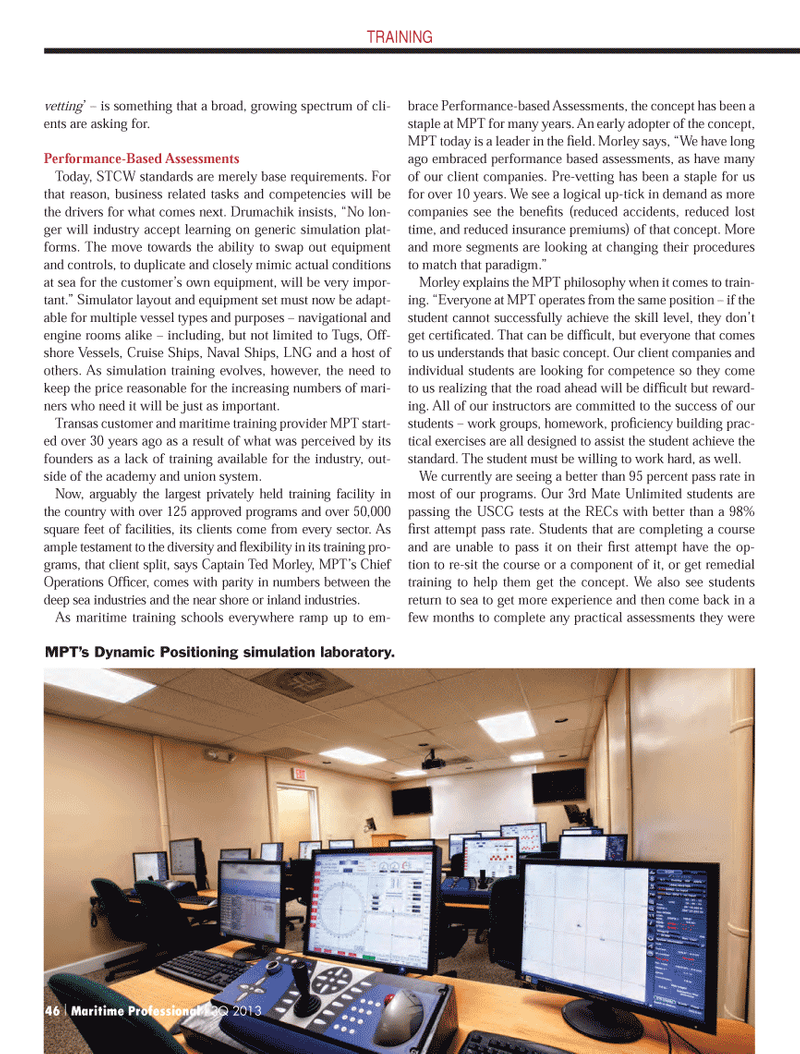
Page 46: of Maritime Logistics Professional Magazine (Q3 2013)
Training & Security
Read this page in Pdf, Flash or Html5 edition of Q3 2013 Maritime Logistics Professional Magazine
vetting? ? is something that a broad, growing spectrum of cli- ents are asking for. Performance-Based Assessments Today, STCW standards are merely base requirements. For that reason, business related tasks and competencies will be the drivers for what comes next. Drumachik insists, ?No lon- ger will industry accept learning on generic simulation plat-forms. The move towards the ability to swap out equipment and controls, to duplicate and closely mimic actual conditions at sea for the customer?s own equipment, will be very impor- tant.? Simulator layout and equipment set must now be adapt- able for multiple vessel types and purposes ? navigational and engine rooms alike ? including, but not limited to Tugs, Off- shore Vessels, Cruise Ships, Naval Ships, LNG and a host of others. As simulation training evolves, however, the need to keep the price reasonable for the increasing numbers of mari- ners who need it will be just as important.Transas customer and maritime training provider MPT start- ed over 30 years ago as a result of what was perceived by its founders as a lack of training available for the industry, out- side of the academy and union system. Now, arguably the largest privately held training facility in the country with over 125 approved programs and over 50,000 square feet of facilities, its clients come from every sector. As ample testament to the diversity and exibility in its training pro- grams, that client split, says Captain Ted Morley, MPT?s Chief Operations Of cer, comes with parity in numbers between the deep sea industries and the near shore or inland industries. As maritime training schools everywhere ramp up to em- brace Performance-based Assessments, the concept has been a staple at MPT for many years. An early adopter of the concept, MPT today is a leader in the eld. Morley says, ?We have long ago embraced performance based assessments, as have many of our client companies. Pre-vetting has been a staple for us for over 10 years. We see a logical up-tick in demand as more companies see the bene ts (reduced accidents, reduced lost time, and reduced insurance premiums) of that concept. More and more segments are looking at changing their procedures to match that paradigm.? Morley explains the MPT philosophy when it comes to train- ing. ?Everyone at MPT operates from the same position ? if the student cannot successfully achieve the skill level, they don?t get certi cated. That can be dif cult, but everyone that comes to us understands that basic concept. Our client companies and individual students are looking for competence so they come to us realizing that the road ahead will be dif cult but reward- ing. All of our instructors are committed to the success of our students ? work groups, homework, pro ciency building prac- tical exercises are all designed to assist the student achieve the standard. The student must be willing to work hard, as well. We currently are seeing a better than 95 percent pass rate in most of our programs. Our 3rd Mate Unlimited students are passing the USCG tests at the RECs with better than a 98% rst attempt pass rate. Students that are completing a course and are unable to pass it on their rst attempt have the op- tion to re-sit the course or a component of it, or get remedial training to help them get the concept. We also see students return to sea to get more experience and then come back in a few months to complete any practical assessments they were TRAININGMPT?s Dynamic Positioning simulation laboratory. 46 I Maritime Professional I 3Q 2013MP #3 34-49.indd 46MP #3 34-49.indd 469/10/2013 11:15:55 AM9/10/2013 11:15:55 AM

 45
45

 47
47
